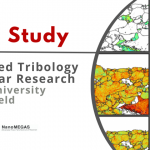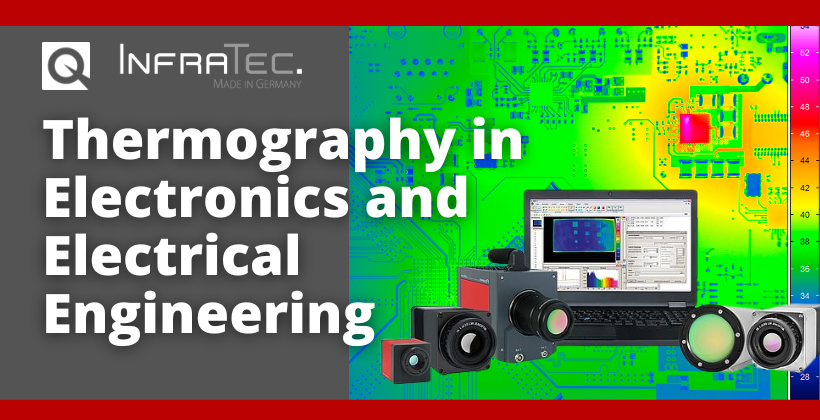
The use of infrared thermography in electronics and electrical industry allows contactless measurement of surface temperatures with an infrared camera without contacting temperature sensors. It is an elegant, non-invasive optical temperature measurement method for simultaneous and temporally high-resolution detection of a number of measurement points.
Infrared Camera Enables Contactless Measurement in Electronics
The thermographic inspection of electronic components and assemblies is an established test procedure for failure detection and quality management – from the development of first prototypes to serial production. This enables, for example, the following to be detected:
- Hotspots and atypical temperature distributions on the surface of printed circuit boards, integrated circuits and multichip modules
- Increased contact resistances
- Increased resistance due to constriction of wires
- Hidden cracks in joints
- Power losses due to RF mismatch
- Incorrect thermal connections of heat sinks
- Short circuits, soldering defects such as cold solder joints
Thermographic analysis during each development step provides important conclusions for the optimisation of heat management and the design of complex electronic assemblies. In electronics production thermographic temperature measurement is used as a versatile instrument for quality assurance. High-performance thermography has become indispensable for setting critical technological parameters and their permanent monitoring as well as for inline testing of products in the production process and their final functional test.
Further Characteristics of the Use of Thermography in Electrical Engineering and Electronics
- Influences neither the RF impedance of the measurement object nor the heat dissipation of the same, which serves the safe avoidance of corresponding measurement errors
- Allows safe temperature measurement even on live working parts
- Complete recording of the temperature distribution and its temporal course of complex assemblies
- Highest spatial resolution by using measurement systems with detectors with a very high number of pixels and opto-mechanical MicroScan unit
- Resolution of smallest geometrical structures using close up lenses and infrared microscope lenses
- Detection of smallest temperature differences using cooled photon detectors and lock-in measurement methods
- Easy-to-use analysis and documentation of measurement results with powerful analysis software
Advantages when Using Powerful Thermographic Systems




- Detector resolutions up to (1,920 × 1,536) native IR pixels for testing complex assemblies
- Capturing of high-resolution detail images with pixel sizes up to < 1 μm using specific microscopic lenses
- Detection of temperature differences between defective and intact structures in the range of a few micro-Kelvin due to high thermal resolution up to < 0.015 K in combination with the lock-in method
- Measurement accuracy of up to ± 1 °C or 1 % for accurate measurement results
Individual Configuration of Thermographic Systems for Electronics and Electrical Engineering
Depending on the respective task, users can get the equipment configured meeting their specific needs. The starting point will usually be the thermographic camera. Cooled or uncooled detector? Which detector format? Shall the thermographic system support lock-in thermography? How much flexibility is desired for the distance between the measurement object and the camera? What influence does this have on the choice of microscopic lenses and close-ups? Depending on what the answers to these questions will be, InfraTec can offer thermographic systems of various performance levels – from the individual camera to the automated modular E-LIT test bench.
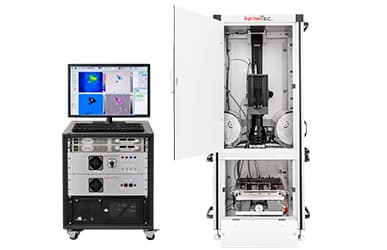
Electronic / Semiconductor Testing – E-LIT
Detect inhomogeneous temperature distribution and local power loss during the production using the automated modular test bench for Lock-in thermography. learn more >>
Precise Localisation and Detailed Mapping of Hotspots and Temperature Differences
The principle of non-contact thermographic temperature measurement allows the error-free determination of the temperature of small objects with small heat capacity. This is often impossible, however, even when using the smallest contacting temperature sensors, as their heat dissipation frequently falsifies the measurement results. In many cases, the use of thermocouples is impossible due to the design or function of the circuit itself. In addition, the structures of electronic measurement objects are sometimes so small that temperature sensors cannot be attached to them.
However, thermographic systems with a high spatial resolution are able to make such small structures clearly visible and, in addition, to determine their exact temperature distribution along with their chronological sequence. By means of specific close-ups and powerful infrared microscopic lenses, users can thermographically measure hotspots of just a few micrometres in size on the surface of components such as semiconductor components. If SIL lenses (Solid Immersion Lenses) are additionally used, even smaller structure sizes can be detected. In combination with appropriate active thermography methods (lock-in thermography), temperature differences of less than 1 mK are clearly visible for failure localisation.
InfraTec offers matching lenses and cameras with cooled and uncooled detectors with native resolutions up to (1,920 × 1,536) IR pixels. With MicroScan – available for cameras with both cooled and uncooled detectors – the spatial resolution can be further improved. The thermograms obtained in this way ensure that components and assemblies are depicted down to the smallest detail and that failures can be precisely detected and localised. Thermal images with an enormous spatial resolution of a few megapixels pay off especially for complex assemblies, where many structures can be captured simultaneously on the respective measurement and test object. If the pixel number of the detector of the used camera is too small, the number of images required for the complete acquisition of the measurement object increases.
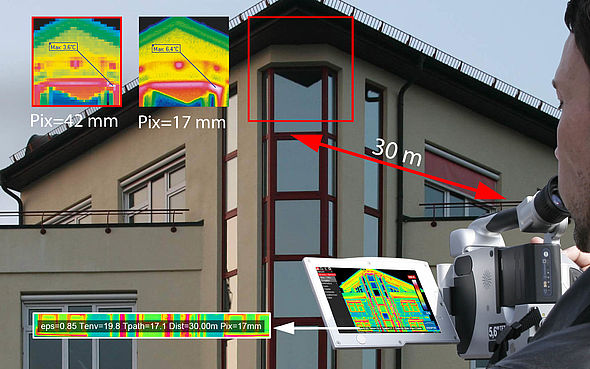
Lock-in Thermography in Electronics and Electrical Engineering
By means of lock-in analysis procedure of InfraTec’s IRBIS® 3 active, errors that only cause mK or μK deviations can be reliably detected and assigned to their location:
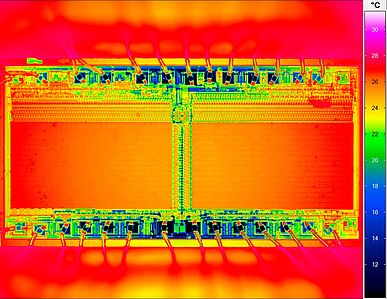
Classical thermal imaging – defect not detectable
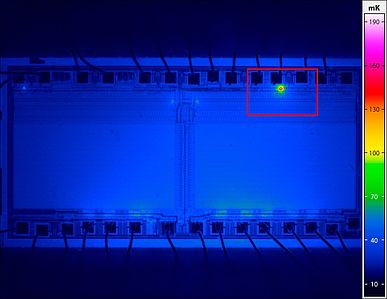
Amplitude image – analysis by Lock-in Thermography
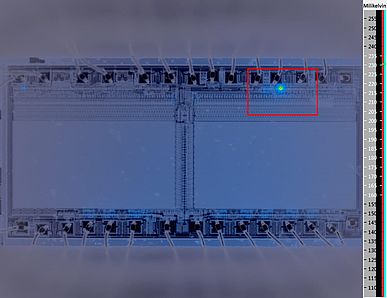
Combination of live and amplitude image
Case Studies about Thermography in Electronics Applications
Thermography on the Trail of the Fault
Today, thermographic damage and function analysis of electronic componenets is an established test method in electrical engineering. This method is also used for research purposes at the Institute for Electrical Systems and Energy Logistics at BTU Cottbus-Senftenburg. In this context, Prod. Dr. Ralph Schacht is intensively involved with the material and system characterisation as well as the non-destructive failure analysis of printed circuit boards, electronic components, microelectronics and composite systems of packaging and interconnection technology.
Thermal Micro Actuators for Nanotechnologies
Microelectromechanical systems (MEMS) offer a wide range of possible applications in the field of nanotechnology. Everyday examples are the position recognition of mobile phone and the use in airbags, digital cameras or pacemakers. Other applications can be found above all in the field of miniaturised medical diagnostics. Growing demands on miniaturisation affect both the system solutions required for this and the sensors and control elements to be developed.
Power Electronics – Efficient Control of the Futures Energy
The energy efficiency of electronic components is becoming increasingly important in numerous fields of application. And that is not all: in our electronic and high0tech age, the demand is for even faster active components, higher power densities of miniaturised systems as well as absolute reliability. Along with this, there is the request for environmentally conscious resource procurement and the requirement that the increase in performance of modules should run parallel to lower energy consumption.
Thermography in Process Automation
Heat is one of the most important parameters for weal and woe during production processes and for product quality. Therefore, measuring heat was always had major relevance which is reflected by the early use of temperature sensors during the automation of production processes. Now the fast visualisation of temperature distributions with non-contacting infrared thermography allows even more complex automated solutions without using contacted temperature sensors.
Clear Determination of only a Few Milli-Kelvin Temperature Differences

In general, thermography has now found a firm place in applications within electronics and electrical engineering. Reasons for this include the trend towards ever smaller, but at the same time more powerful components that are operated with ever lower supply voltages. Normally, lower electrical power consumption goes hand in hand with lower temperature changes from which any faults that may occur can be analysed. Infrared cameras with excellent thermal resolutions up to < 20 mK in real-time operation already fundamentally meet these requirements. However, this alone is not sufficient for certain measurement tasks. In addition, lock-in thermography will be required to detect slightest temperature differences. By means of periodic excitation, test objects can be examined non-destructively for defects and irregularities. The measurement time when using the lock-in method increases significantly with the desired resolution compared to a real-time measurement and can take several minutes. Therefore, it is particularly helpful if such measurements can be made “in one go” with a large-format camera providing high geometrical resolution.
A camera with a lower geometrical resolution, in contrast, forces the user to repeat measurements many times during the complete acquisition of the measurement object, especially if a failure cannot always be reliably reproduced. The money saved on purchasing a lower-cost camera then causes the developer to waste a lot of time on testing or production during the final inspection and can result in considerably higher costs.
Precise Results in the Shortest Possible Time
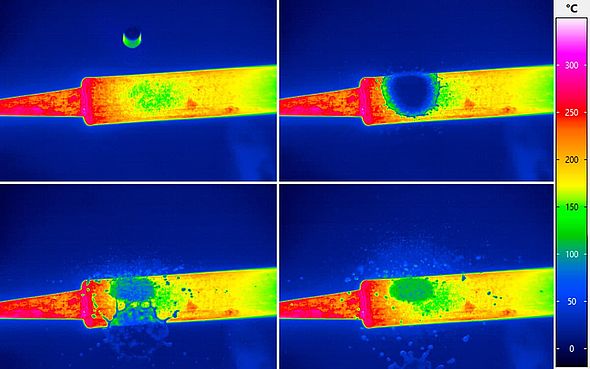
High-speed Mode – Increase Frame Rate and Sensitivity
Due to the binning technology, infrared cameras have two speed modes – the standard mode and the high-speed mode, in which the frame rate increases more than three times. The field of view remains constant in both modes, so the scene captured by the camera does not change. In high-speed mode, the thermal resolution also increases by a factor of two.
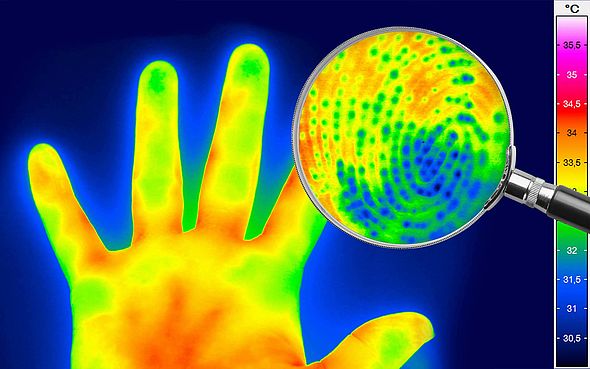
MicroScan – Quadrupling the Number of Pixels
Displaying measurement objects with extremely low noise and fine resolution – this is what MicroScan is for. Using this function, the native pixel number of the detector can be quadrupled. This results in thermograms of better image quality with geometric resolutions of more than 5.2 Megapixels. Each pixel in the image represents a true temperature reading, not an interpolated pixel.
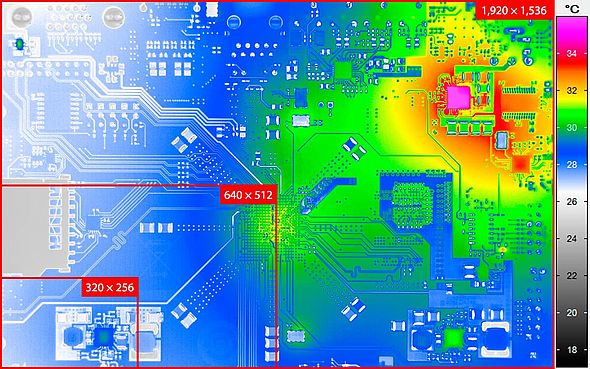
Geometrical Resolution – Efficient Analysis of Complex Assemblies
InfraTec’s infrared cameras with cooled and uncooled detectors have native resolutions up to (1,920 × 1,536) IR pixels. Spatially high-resolution thermograms ensure that components and assemblies are imaged down to the smallest detail and thus defects can be reliably detected and precisely localised.

Thermal Resolution – Determination of Differences of Only a Few Millikelvin
For detection of small temperature changes InfraTec’s infrared cameras offer thermal resolutions up to < 15 mK in real-time operation. By using the Lock-in Thermography method it is possible to further increase this resolution significantly. For this purpose test objects are periodically excited and non-destructively examined for defects and irregularities.
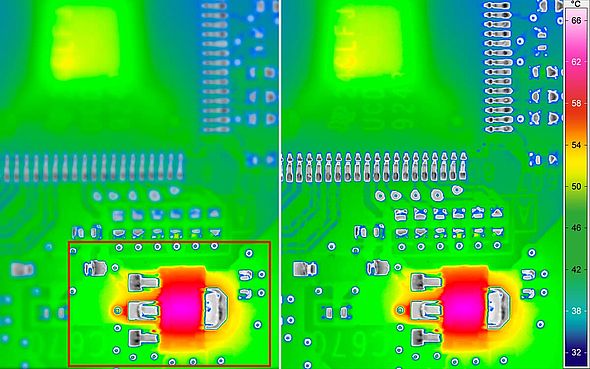
EverSharp – Displaying Measurement Objects in a Sharp Thermal Image Consistently
The EverSharp function allows all objects in the image scene to be sharp. The automatic combination of thermal images with different focus positions ensures that only the sharply focused object structures are shown in the resulting thermal image.

HighSense – Always the Optimal Camera Setting
Thanks to HighSense, ImageIR® users have the option of setting up individual measuring ranges based on the factory calibration that best suit the respective task. The software also offers the possibility of storing a large number of such areas clearly arranged. Individually named and permanently stored, the operator can quickly access them. The same applies to changing, renaming and deleting profiles. HighSense is available for different camera models of the ImageIR® series. This function can optionally be added to systems already delivered.
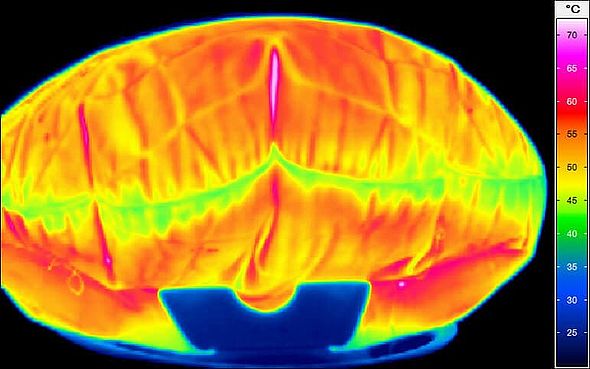
Window Mode (Subwindowing) – Capture of Rapid Sequences
The thermal imaging camera can be operated in full, half, quarter and sub mode. With the camera control software, it is possible to use the extended subwindowing function. Using click-and-drag, freely definable sections can be set up quickly and conveniently. A defined sub-frame of the detector is picked out to achieve these extremely high refresh rates.
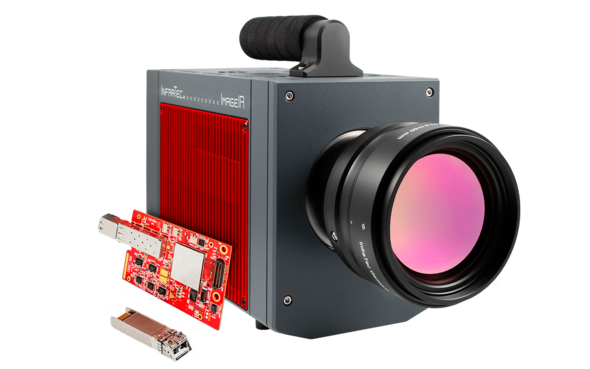
10 GigE Interface for a Strong Increase in Output
The 10 Gigabit Ethernet interface of the high-end camera series ImageIR® opens this extremely fast transmission standard with a NIC specially developed by InfraTec. This works with optical or electrical transceiver modules that are easy to change and are called SFP+.
Excellent Coordination of Infrared Camera, Thermography Software and Peripherals
InfraTec pays special attention to the optimal interaction between the thermographic camera and the software. Regarding the use in electronics manufacturing, the IRBIS® 3 thermography software offers a wide range of functions that support the use of passive and active thermography methods. These include, for example, the comparison between current thermal images and a reference image as well as the display of amplitudes and phase images with adjustable parameters for lock-in thermography. This allows the failure target to be reliably identified and clearly displayed.

The IRBIS® 3 also offers a tailored solution for thermographic measurements on printed circuit boards and hybrid assemblies. A great challenge with such measurement objects arises from the abundance of components used. These again consist of a variety of materials, such as different metals, ceramics and plastics, each with very different surface attributes. For precise temperature measurement, the emissivity of the respective material at the surface is of particular importance. With the IRBIS® 3 software the emissivity for each individual pixel can both be determined and adjusted and so the measured temperature can automatically be corrected taking into account the emissivity and any reflected temperature. Various correction models are used for this and for taking into account other influencing factors, too. These models reproduce the respective measurement situation in such a way that all factors influencing the measurement result, such as radiation from the surroundings, windows used or damping properties of the measurement section, are taken into account. This allows the user to always achieve exact temperature measurement results if the relevant conditions are met.

Ready to learn more?
Discuss your requirements with our Technical Sales Manager, Dr. Luke Nicholls by email or call (01372) 377882




